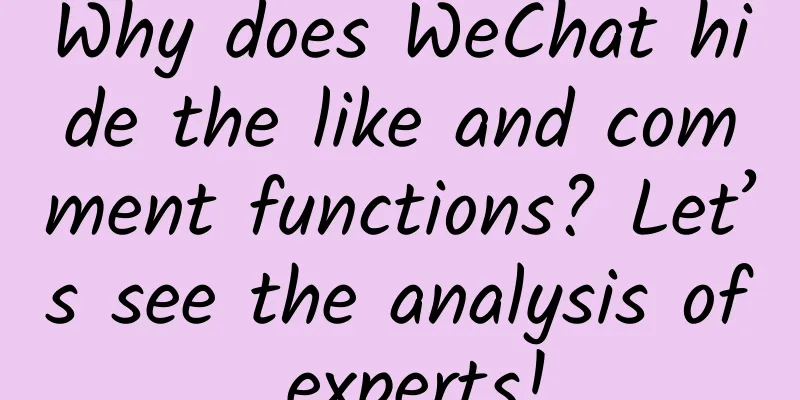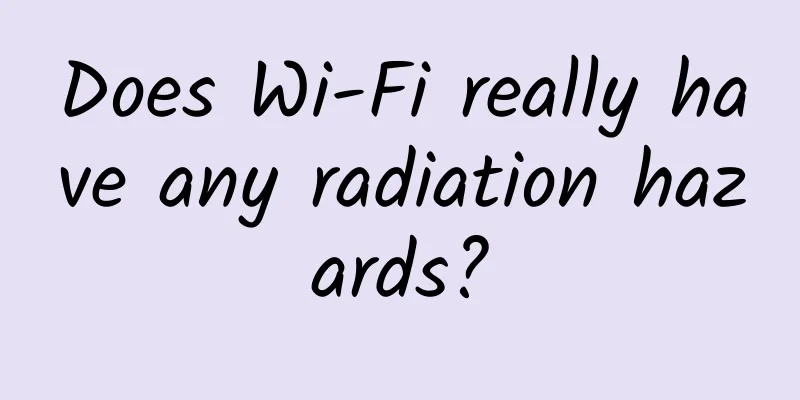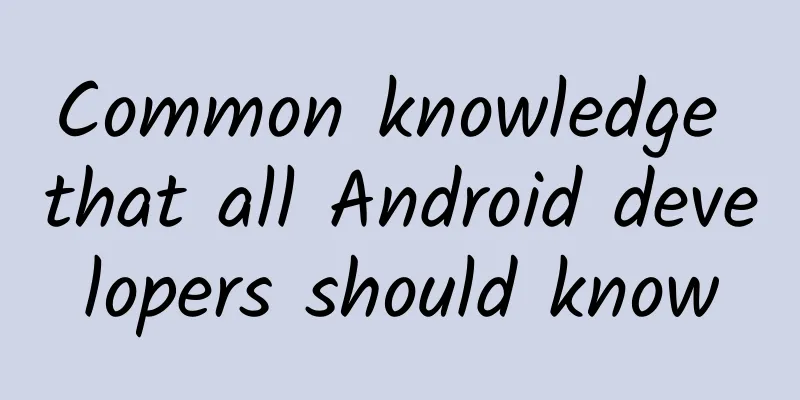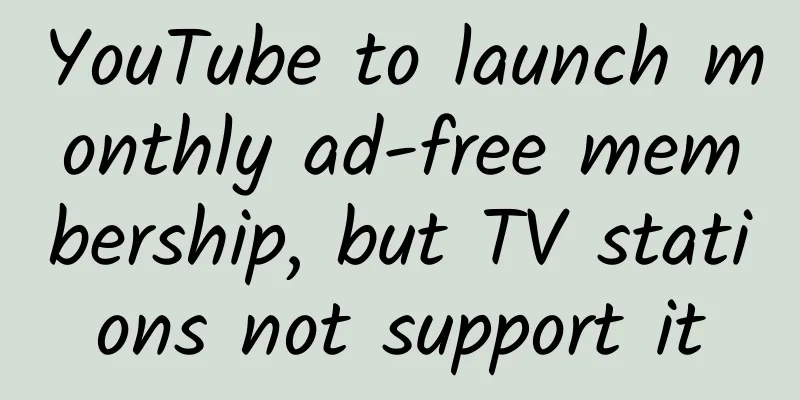Why does WeChat hide the like and comment functions? Let’s see the analysis of experts!

|
Reader Question: Mr. Dai, why does WeChat hide the like and comment functions? I personally think that this is a very old and basic question. There are many discussions about this issue on the Internet. For example, there is a special question like this on Zhihu, and many of the answers under the question make sense. For example, the highly praised answer from Zhihu user JimSoup says:
If you put likes in comments, many times people post very daily things, and the lack of desire to comment will affect the likes. So, you need to have both comments and likes. Likes have a slightly higher priority than comments. If you want to respond briefly, click like; if you have questions or something to say, post a comment. Finally, you will find that hiding likes and comments is a good idea. When you can't see the options, you only have one thought in your mind: I want to reply. Until you click it, you will continue to think about whether you want to like or comment. This makes likes and comments relatively real, and will not mislead users' operations due to UI. This answer makes sense. There are some other good answers here. If you are interested, you can take a look. However, whether it is hidden or displayed directly on the current page, it is just a design form. If we separate the product and the user and directly compare the design form, it is definitely incomplete and meaningless. You can even directly ask the WeChat designer why he designed it this way. The other party may tell you that they think it is too conspicuous, so they hide it, that's all. So we can talk about it in a broader sense, such as how this feature affects the user's behavior in the product. The whole thinking process can start from these questions, that is, what needs of users does the feature meet? What are these users like? How does the product understand this need of users? According to the first question above, we can say that likes and comments satisfy users’ needs for “interaction” with friends’ dynamics in “WeChat Moments”. So what are these users like? It is clear from the user's friend relationship that WeChat's original product design concept is based on social interaction among acquaintances. Compared with other social products, friend relationships are more in-depth and private. However, as the usage rate of WeChat increases and users explore its different uses, such as work, selling goods, etc., users' address books have begun to flood with more "friends" who are not acquaintances and have different relationship chains. This trend is also reflected in many privacy-limited functions of WeChat, such as "chat only". So back to the last question, that is, how to understand the user's interactive needs? Interactive people In an article I wrote a while ago, I mentioned that content products can like information posted by other users, which is actually a kind of information recommendation, and its role is to promote content. For example, if you like a post about pesticides, the system will push similar posts to you; or if users like your post to a certain amount, your post will become popular, etc. If this function is not present, then clicking on the like button only satisfies the user's vanity and has no practical significance. The privacy of WeChat Moments is in contrast to the openness of many other content-based products. In other products, the visible like and comment icons and the number of interactions are all trying to create a lively and onlooker atmosphere, thereby attracting you to browse the content and interact quickly. The main thing that attracts attention is the number of likes. However, the likes and comments on Moments are only visible to friends and mutual friends. This means that likes and comments are mainly between friends, so the core is not how many people like it, but who likes or comments it. For example, if childhood friend A and colleague B post the same joke, they will definitely interact with the one they have a better relationship with. In this case, the product should focus the user's attention on people. Therefore, irrelevant information on the page is hidden, allowing friends to focus more on the content posted by people. For example, when you see someone you like post a circle of friends, you can interact with them based on the content. Therefore, for Moments, the essence of interaction is not just curiosity and communication about content, but interest in people. When users browse information in Moments, they are not discovering new information, but getting to know their friends. If they don’t like or even dislike someone, they can block the “person” to ensure that they have a “clean” Moments. Therefore, for WeChat, Moments should be a secondary social interaction between friends, rather than the primary social interaction. For example, if you add a colleague as a WeChat friend and see a Moments post from him, you will get to know him one step further, rather than adding him as a friend through Moments information and then getting to know him better. The essential difference here is that the Moments are a secondary part of friendships. Since it is a secondary part, there is no need to guide users to interact and occupy the main information in the Moments. Therefore, liking and commenting are not what WeChat guides users to do, but what users are willing to do themselves, because from people to content, if they are interested, then their intrinsic motivation will be strong enough and they will not care about the operation of clicking one more time. This is very critical. This hiding may seem like an obstacle, but it is actually a means of filtering out invalid interactions, allowing users to focus more on people and content and generate higher quality interactions. Social pressure to interact Zhang Xiaolong said in a speech at the beginning of 2019:
It’s not just about posting to Moments, it’s also the same for interactions. When your voice is heard by more familiar people, social pressure will follow. In other words, even if you want to interact with someone, you have to see who your common friends are with that person. For example, when you see that your cousin is getting married, you really want to give a like, but you’re afraid that your mother will see it and use this opportunity to urge you to do so, so you decide to just give up. In this case, WeChat did not choose to display the interactive button in the front in the subsequent revision, which is also in line with the user's psychology. Since interaction has become a kind of pressure for users, why should this pressure be magnified? Moreover, as a communication tool, WeChat can directly transform users’ attention to Moments into communication with friends. Users no longer need to interact in the Moments environment, and private chat is also good. For example, there are some content products where many comments are sensational, such as "If there weren't acquaintances here, I would have said something like this." Although there is some humor and ridicule in it, it is indeed the voice of some people. Or the video account’s friends’ likes dynamics, which also prevents many people from liking the content they like, for fear that their little fun will be discovered by their friends and relatives on WeChat. In fact, it’s a similar reason. Therefore, when the object of interaction has the attribute of "acquaintance", "social pressure" will follow. So it is better to focus the user's attention directly on the person and the content posted, and hide the secondary information. If they are interested, they will naturally interact, and there is no need to guide them - after all, it is impossible to guide them. summary Behind likes and comments is the need for interaction, but interaction has a context. For example, in a friendship, "people" are the key to interaction. Therefore, after understanding user needs, how the product implements or guides user behavior under such needs reflects the original design concept or design direction of many products, which are not only related to the design of a function. Many of the questions I received from readers were about the functional design of specific applications. When I asked them about their own understanding, many people directly started to analyze from the functional design. For example, in today's question, most people's disputes focused on the advantages and disadvantages of directly displaying and hiding functions. This method cannot be said to be wrong, but it is easy to have limitations, because once we think in this way, the starting point is not the actual needs of users, but only the quality of functional forms. Of course, my interpretation is just to think about the possibilities behind some products from the perspective of function. But at least thinking about the essence of the problem will be much richer and more interesting than talking about function and form. I think this is also the part that designers should expand in addition to function and form. |
<<: Amap launches AR driving navigation: try real-scene navigation on your mobile phone!
>>: Android WeChat 7.0.18 released: taps can be withdrawn, and comments in Moments can be deleted
Recommend
Color: Six major mysteries of Google Play
When I saw the title and the word "cai"...
WeChat message reception delay? It turns out they are playing tricks, here's how to fix it with one click
We use WeChat every day. Have you noticed that so...
The product has attracted new users, how to retain them?
In the past, “born by attracting new customers, d...
Bidding hosting: Summary of SEM bidding account issues
We often hear people complain that SEM promotion ...
Analyzing the 4 ways to use Douyin to promote accounts!
What is a Douyin account? A Douyin account that i...
Speed! How to keep 15GB of OneDrive space before 3pm
Last November, Microsoft announced that it would ...
What technological forces are behind the successful return of Shenzhou-14?
At 20:09 on December 4, the return capsule of the...
Video account IP evolution wealth camp, from 0 to 1, from positioning to monetization to make money (worth 1577 yuan)
Video account IP evolution wealth camp, from 0 to...
A sophisticated and magical structure hidden in your body
Produced by: Science Popularization China Produce...
Can metals be made into glass? You'll never think of its applications
Produced by: Science Popularization China Author:...
Weird things that happened on WeChat
[[142690]] While eating lunch and browsing Moment...
How does Xiaomi increase its private domain user base?
WeChat has become a must-use software for almost ...
Ball lightning caused an explosion in the workshop, lightning protection safety should be paid attention to
Ball thunder? What is ball thunder? ▼▼▼ Ball Ligh...
Scary! Microplastic particles found in human blood for the first time. Where do they come from?
Recently, the news that microplastics were found ...
Responsive Image Processing in Web Development
At present, there are relatively good solutions f...









